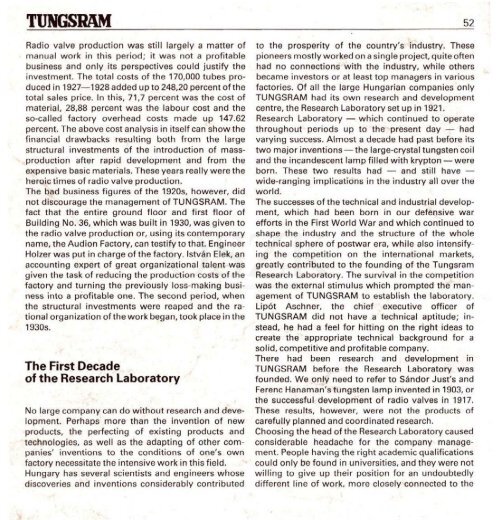THE HISTORY OF TUNGSRAM 1896-1945 - MEK
THE HISTORY OF TUNGSRAM 1896-1945 - MEK
THE HISTORY OF TUNGSRAM 1896-1945 - MEK
- No tags were found...
You also want an ePaper? Increase the reach of your titles
YUMPU automatically turns print PDFs into web optimized ePapers that Google loves.
<strong>TUNGSRAM</strong>-.i-'.V'52Radio valve production was still largely a matter ofmanual work in this period; it was not a profitablebusiness and only its perspectives could justify theinvestment. The total costs of the 170,000 tubes producedin 1927—1928 added up to 248,20 percent of thetotal sales price. In this, 71,7 percent was the cost ofmaterial, 28,88 percent was the labour cost and theso-called factory overhead costs made up 147.62percent. The above cost analysis in itself can show thefinancial drawbacks resulting both from the largestructural investments of the introduction of massproductionafter rapid development and from theexpensive basic materials. These years really were theheroic times of radio valve production.The bad business figures of the 1920s, however, didnot discourage the management of <strong>TUNGSRAM</strong>. Thefact that the entire ground floor and first floor ofBuilding No. 36, which was built in 1930, was given tothe radio valve production or, using its contemporaryname, the Audion Factory, can testify to that. EngineerHolzer was put in charge of the factory. Istvan EIek, anaccounting expert of great organizational talent wasgiven the task of reducing the production costs of thefactory and turning the previously loss-making businessinto a profitable one. The second period, whenthe structural investments were reaped and the rationalorganization of the work began, took place in the1930s.The First Decadeof the Research LaboratoryNo large company can do without research and development.Perhaps more than the invention of newproducts, the perfecting of existing products andtechnologies, as well as the adapting of other companies'inventions to the conditions of one's ownfactory necessitate the intensive work in this field.Hungary has several scientists and engineers whosediscoveries and inventions considerably contributedto the prosperity of the country's industry. Thesepioneers mostly worked on a single project, quite oftenhad no connections with the industry, while othersbecame investors or at least top managers in variousfactories. Of all the large Hungarian companies only<strong>TUNGSRAM</strong> had its own research and developmentcentre, the Research Laboratory set up in 1921.Research Laboratory — which continued to operatethroughout periods up to the present day — hadvarying success. Almost a decade had past before itstwo major inventions — the large-crystal tungsten coiland the incandescent lamp filled with krypton — wereborn. These two results had — and still have —wide-ranging implications in the industry all over theworld.The successes of the technical and industrial development,which had been born in our defensive warefforts in the First World War and which continued toshape the industry and the structure of the wholetechnical sphere of postwar era, while also intensifyingthe competition on the international markets,greatly contributed to the founding of the TungsramResearch Laboratory. The survival in the competitionwas the external stimulus which prompted the managementof <strong>TUNGSRAM</strong> to establish the laboratory.Lipot Aschner, the chief executive officer of<strong>TUNGSRAM</strong> did not have a technical aptitude; instead,he had a feel for hitting on the right ideas tocreate the appropriate technical background for asolid, competitive and profitable company. ' ^..There had been research and development in<strong>TUNGSRAM</strong> before the Research Laboratory wasfounded. We only need to refer to Sandor Just's andFerenc Hanaman's tungsten lamp invented in 1903, orthe successful development of radio valves in 1917.These results, however, were not the products ofcarefully planned and coordinated research.Choosing the head of the Research Laboratory causedconsiderable headache for the company management.People having the right academic qualificationscould only be found in universities, and they were notwilling to give up their position for an undoubtedlydifferent line of work, more closely connected to theI; ' •'?-








![Letöltés egy fájlban [4.3 MB - PDF]](https://img.yumpu.com/50159926/1/180x260/letaltacs-egy-fajlban-43-mb-pdf.jpg?quality=85)







